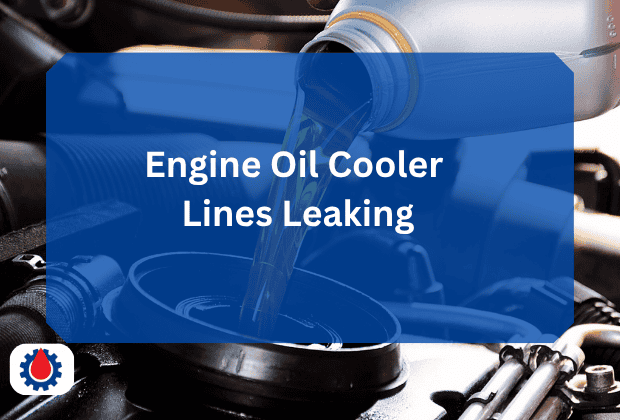An engine oil cooler helps regulate engine oil temperature to prevent overheating and maintain optimal performance. However, when these lines start leaking, it can lead to serious engine issues if not addressed promptly.
In this guide, we’ll explore the causes, symptoms, and solutions for engine oil cooler line leaks, helping vehicle owners understand this common problem and how to tackle it effectively.
Engine Oil Cooler Lines Leaking
Causes of Engine Oil Cooler Line Leaks
1. Wear and Tear Over Time
Like any component exposed to heat, pressure, and environmental factors, oil cooler lines degrade over time. Rubber hoses, in particular, can become brittle, crack, or develop small tears due to constant exposure to high temperatures and engine vibrations. Metal lines, while more durable, can corrode or develop fatigue cracks.
2. Improper Installation or Maintenance
If the lines were not installed correctly during a previous repair or maintenance, they may not be properly sealed, leading to leaks. Loose fittings, overtightened clamps, or incompatible replacement parts can also cause issues.
3. Corrosion and Rust
Metal oil cooler lines are susceptible to rust, especially in regions with harsh weather conditions or road salt exposure. Corrosion weakens the lines, creating pinholes or cracks that allow oil to escape.
4. Physical Damage
Oil cooler lines are often located in vulnerable areas of the engine bay, where they can be damaged by road debris, accidents, or contact with other components. A small dent or puncture can cause a significant leak.
5. High Oil Pressure
Excessive oil pressure, often caused by a malfunctioning oil pump or clogged oil passages, can stress the lines beyond their capacity, leading to bursts or leaks at weak points.
Related Oil Leak Between Engine and Gearbox(5 Causes + Solutions)
Symptoms of a Leaking Oil Cooler Line
1. Visible Oil Leaks
One of the most obvious signs is oil pooling under your vehicle after it’s been parked. Check for dark, slick spots on the ground or oil residue on engine components near the oil cooler lines.
2. Low Oil Levels
If you frequently need to top off your engine oil or notice the oil level dropping faster than usual, a leak in the oil cooler lines could be the culprit. Check your dipstick regularly to monitor oil levels.
3. Burning Oil Smell
Leaking oil may drip onto hot engine parts, such as the exhaust manifold, causing a distinct burning oil smell. You might also notice smoke or haze coming from the engine bay.
4. Engine Overheating
Since the oil cooler helps regulate oil temperature, a leak can reduce the system’s efficiency, causing the engine to overheat. Keep an eye on your temperature gauge for unusual spikes.
5. Reduced Engine Performance
Low oil levels due to a leak can lead to inadequate lubrication, resulting in sluggish performance, increased engine noise, or even knocking sounds.
Related Engine Oil Leak – 7 Alarming Signs(How to Fix Them)
Solutions for Leaking Oil Cooler Lines
Addressing a leak promptly is crucial to avoid engine damage. Here are the steps to diagnose and fix the issue:
1. Inspect the Lines
Start by visually inspecting the oil cooler lines for signs of damage, such as cracks, corrosion, or loose fittings. Use a flashlight to check hard-to-reach areas and look for oil residue. If you’re not confident in your ability to inspect, consult a professional mechanic.
2. Tighten or Replace Fittings
If the leak is coming from a loose connection, tightening the fittings may solve the problem. However, be cautious not to overtighten, as this can damage the threads or seals. If the fittings are damaged, replace them with OEM (original equipment manufacturer) parts for a proper fit.
Related Best Pipe Thread Sealant for Fuel Oil Applications(Top 5 Picks 2025)
3. Patch Small Leaks (Temporary Fix)
For minor leaks, a high-quality sealant or tape designed for automotive oil lines can serve as a temporary fix. However, this is not a long-term solution, as patches may fail under high pressure or heat.
4. Replace the Lines
In most cases, replacing the damaged oil cooler lines is the best solution. Use OEM or high-quality aftermarket lines compatible with your vehicle. Rubber hoses are easier to replace but may wear out faster, while metal lines are more durable but require precise installation.
5. Address Underlying Issues
If the leak was caused by high oil pressure or corrosion, address these root causes. Have your oil pump and cooling system inspected to ensure they’re functioning correctly. Regular maintenance, such as flushing the cooling system and using the recommended oil type, can prevent future issues.
6. Professional Repair
If the leak is severe or you’re unsure about performing the repair, take your vehicle to a trusted mechanic. They can perform a pressure test to pinpoint the leak and ensure the repair is done correctly.
Related How to Fix an Oil Leak Between Engine and Transmission(In 5 Steps)
Preventing Future Leaks
To avoid oil cooler line leaks in the future, follow these preventive measures:
- Regular Inspections: Include the oil cooler lines in your routine vehicle maintenance checks. Look for signs of wear, corrosion, or loose connections.
- Use Quality Parts: Always use OEM or high-quality aftermarket parts for repairs to ensure durability and compatibility.
- Monitor Oil Levels: Check your oil levels regularly to catch leaks early before they cause engine damage.
- Drive Carefully: Avoid rough terrain or debris that could damage the lines, especially in low-clearance vehicles.
- Follow Maintenance Schedules: Adhere to your vehicle’s recommended maintenance schedule, including oil changes and cooling system flushes.
Related Best Oil for High Performance Engines(Top 5 Best 2025)
Final words
Leaking engine oil cooler lines are a common but serious issue that can lead to low oil levels, engine overheating, and costly repairs if ignored. By understanding the causes, such as wear and tear, corrosion, or physical damage, and recognizing symptoms like oil puddles or burning smells, you can take action early.
Whether you opt for a temporary patch or a full replacement, addressing the problem promptly is key to keeping your engine running smoothly. Regular maintenance and inspections can go a long way in preventing leaks, saving you time and money in the long run. If you’re unsure about diagnosing or fixing the issue, don’t hesitate to consult a professional mechanic to ensure your vehicle stays in top shape.




